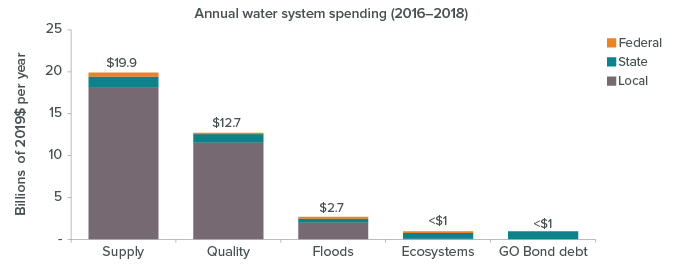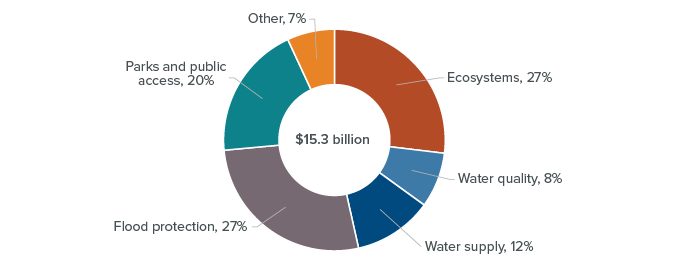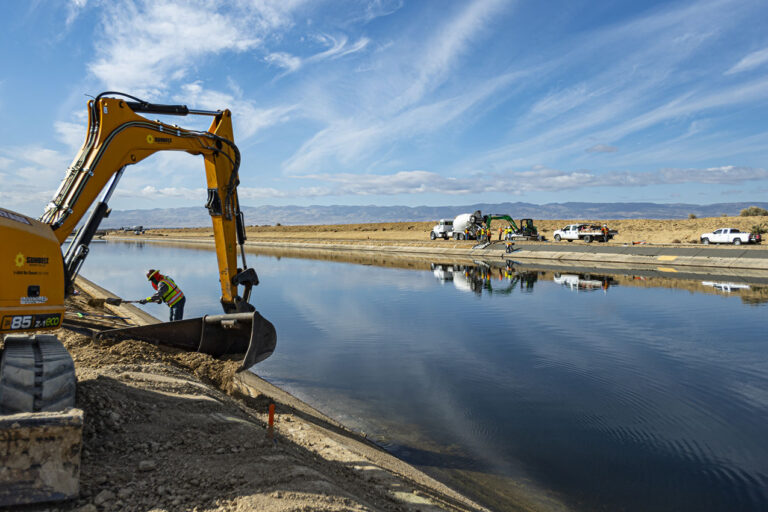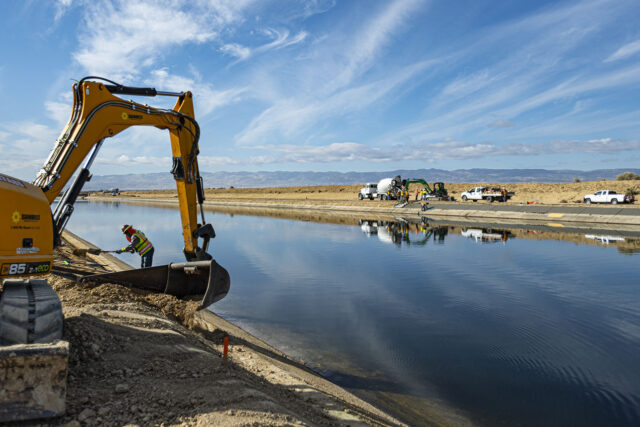- Most funding for California’s water system comes from local utilities.
The state’s extensive water system supplies cities and farms; prevents pollution of lakes, rivers, and coastlines; protects against floods; and supports freshwater ecosystems and the forested headwaters that are a major source of water supply. Many local, state, and federal agencies oversee this system and raise revenues from a variety of sources. California spends about $37 billion annually, with the lion’s share (84%) coming from local water bills and taxes. The balance comes from state (13%) and federal (3%) contributions.
Local utilities raise most of the money spent on water in California

SOURCE: Updated from E. Hanak et al., Paying for Water in California (PPIC, 2014).
NOTES: The figure reports average spending for 2016‒18. Local expenditures exclude grants from higher levels of government. The water quality category includes management of wastewater and approximately $500 million for polluted stormwater and other runoff. GO bond debt service is repayment of state general obligation bonds.
- Water and wastewater rates have been rising as utilities invest in system upgrades.
California’s urban water and wastewater agencies face some fiscal challenges, including how to balance their books during emergencies, such as major droughts and recessions, when revenues decline. Overall, they are in reasonably good fiscal health. Urban utilities have generally been able to raise funds to replace aging infrastructure and to comply with new water treatment requirements. Yet bills have been rising faster than inflation to keep pace with these infrastructure updates, alongside new investments to manage a changing climate. For low-income households, rising rates can lead to affordability and access issues—a challenge heightened during the COVID-19 recession. - State bonds play a key role in funding fiscal orphans.
California’s water system includes multiple activities that lack adequate long-term funding sources. Examples of these “fiscal orphans” include providing safe drinking water in small, low-income communities; delivering flood protection; managing polluted stormwater; and stewarding freshwater ecosystems and headwater forests. Since 2000, eight state water bonds have set aside approximately $27 billion for water projects. Although bonds play a small role in overall spending—averaging just $1 billion per year—they are instrumental in filling funding gaps. Since 2000, bonds have devoted roughly $4 billion each to ecosystem restoration and flood management. Bonds also support new programs that do not have local funding streams. For example, Propositions 1 and 68 are supporting the implementation of the 2014 Sustainable Groundwater Management Act (SGMA). Bonds are reimbursed by the state’s general fund, and California is currently repaying nearly $1 billion annually for past water bonds. The proposed 2021 budget included an influx of General Fund support towards many fiscal orphans, supplanting the near-term need for new water and climate bonds.
Bonds approved since 2000 have funded a range of efforts

SOURCE: Authors’ calculations, using bond project spending details from the California Natural Resources Agency.
NOTES: This figure shows water bond project spending through August 2020 for the eight water bonds passed from 2000–18 ($27 billion in spending authorized). Flood protection includes both flood and stormwater management, water supply includes groundwater management projects, and water quality includes wastewater management and drinking water quality projects. Ecosystems includes early state matching funds for environmental benefits of storage projects under Proposition 1. Other includes multi-benefit, integrated regional water management, and administrative projects. Projects were grouped by their primary area of focus, and some projects may generate benefits more broadly.
- Cap-and-trade funds are being used for safe drinking water and forest health.
As part of California’s efforts to ensure safe drinking water for all, the Safe and Affordable Funding for Equity and Resilience program (SAFER) was established in 2019. SAFER provides $130 million annually for 10 years from cap-and-trade revenues and the general fund to help small water systems in low-income communities operate effectively, covering gaps in operations and maintenance, technical assistance, and other costs. It complements other state and federal programs that support capital spending. The governor’s 2021 proposal includes over $1 billion more for safe drinking water and wastewater. In the wake of devastating wildfires and growing recognition of the need to improve forest health, the legislature also earmarked $1 billion from cap-and-trade dollars for forest management from 2019–23. This funding more than quadrupled Cal Fire’s budget in 2019 and 2020. - Constitutional amendments constrain efforts to raise local funds for some projects.
New local fees and taxes could fill funding gaps for some fiscal orphans, but the details are important. Propositions 218 and 26 impose strict cost-recovery requirements on water rates, making it challenging for public water agencies to implement conservation-oriented rates and affordability programs. Proposition 218 also brought stricter voting approval requirements for certain charges and user fees. This has hampered the ability of agencies to fund essential services like flood and stormwater management. Supermajority approval by two-thirds of voters is necessary for local taxes and bonds that provide broad benefits. The success of Los Angeles County’s Measure W—a parcel tax on impermeable surfaces that will raise $300 million annually for stormwater programs—shows it is possible to garner public support for such programs.
Topics
Drought Water Supply Water, Land & Air




